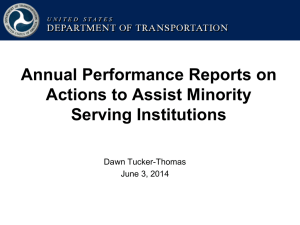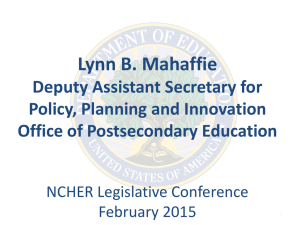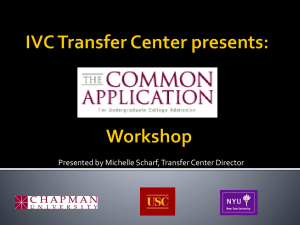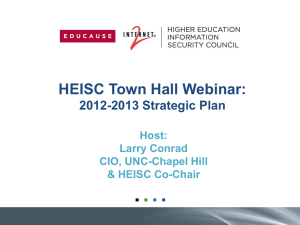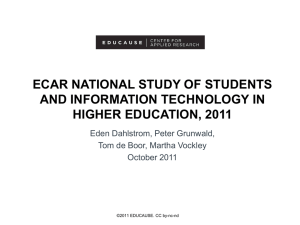Other Students
advertisement
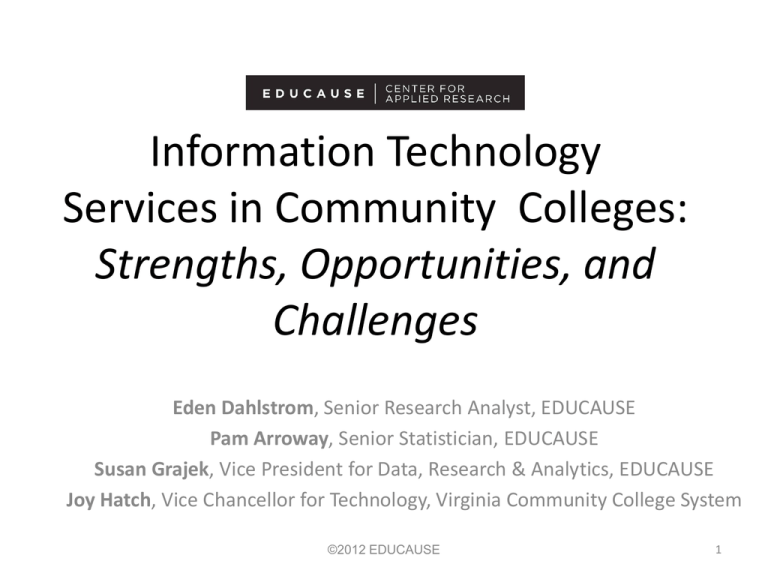
Information Technology Services in Community Colleges: Strengths, Opportunities, and Challenges Eden Dahlstrom, Senior Research Analyst, EDUCAUSE Pam Arroway, Senior Statistician, EDUCAUSE Susan Grajek, Vice President for Data, Research & Analytics, EDUCAUSE Joy Hatch, Vice Chancellor for Technology, Virginia Community College System ©2012 EDUCAUSE 1 Data from these sources were used to create the CC report card. EDUCAUSE 2 Secondary Data Analysis: Data Sources Core Data Service (CDS) survey, 2011 133 community colleges responded to CDS www.educause.edu/cds ECAR National Study of Undergraduate Students and Information Technology, 2011 1,122 community college students from 398 different institutions www.educause.edu/ecar 3 Questions to Ask 1. What do you know about the technologies your students own and how well IT services are meeting their needs? 2. What support do you currently provide to help faculty use technology in teaching? 3. How many students, faculty, and staff does each IT support FTE service? What is your IT cost per FTE? 4. Does your institution’s strategic plan include IT? Do faculty and students have a voice in IT planning? 4 Questions to Ask 5. Do you have a program to minimize IT energy consumption, and, if so, how comprehensive is this program? 6. How safe are your data centers? 7. Do you have a disaster recovery plan, and, if so, when was the last time it was rehearsed? 8. Do you participate in CDS and the student technology surveys to give your institution access to benchmarking data about IT? 5 IT Service Areas Governance Sustainability Teaching and Learning Resource Allocation Managing Risk Management 6 Governance Governance Sustainability Teaching and Learning Resource Allocation Managing Risk Management 7 Institutional Strategic Plan Includes IT Community Colleges All Other Higher Education No 14% Yes 86% No 27% Yes 73% 2011 CDS: M1Q13 (q112) 8 More Likely to Involve Senior Executives in IT Governance 100% Community Colleges 89% All Other U.S. Higher Education 78% 80% 68% 60% 46% 45% 40% 21% 20% 0% President's cabinet/senior executive oversight* Faculty advisory committee* Student advisory committee* * significant at the .01 level 2011 CDS: M1Q15 (q114) 9 Governance: Community Colleges Have Their Acts Together Governance Sustainability Teaching and Learning Resource Allocation Managing Risk Management 10 Sustainability Governance Sustainability Teaching and Learning Resource Allocation Managing Risk Management 11 Progress by Community Colleges FREQUENT Frequent Moderately Common Deployed by Some Rarely Considered MODERATELY COMMON • Central IT program to minimize energy consumption • Campus-wide desktop consumption program to minimize energy consumption DEPLOYED BY SOME • Institutional sustainability policy/plan • Signatory to the ACUPCC • Central IT facilities/equipment located to reduce energy costs • Institutional policy on carbon neutrality RARELY CONSIDERED • Central IT facilities/equipment located to reduce carbon footprint • GHG (greenhouse gas) baseline survey • Submetering of power for data centers • Contribution of central IT to GHG separately reported Leading Higher Education Efforts to Minimize Energy Consumption All Other U.S. Higher Ed. Central IT program to minimize its energy consumption Community Colleges Central IT to min. energy consumption* Campus-wide program to minimize energy consumption of desktop technology 35% 45% Campus program to min. energy consumption Institutional policy or plan for sustainability 34% 43% 0% 20% *significant at the .05 level Institution is a signatory to the ACUPCC Central IT facilities or equipment located or relocated to reduce energy costs Central IT facilities or equipment located or relocated to reduce institution's carbon footprint Institutional policy on carbon neutrality Institutional Type Averages GHG (greenhouse gas) baseline survey DR MA Submetering of power for data centers operated by central IT BA LA BA other AA Contribution of central IT to GHG separately reported 0% 2011 CDS – M1Q17 (q116) 20% 40% 60% 80% The break in the bar represents the U.S. higher education median. 100% 13 40% 60% Sustainability: Making Progress Governance Sustainability Teaching and Learning Resource Allocation Managing Risk Management 14 Teaching and Learning Governance Sustainability Teaching and Learning Resource Allocation Managing Risk Management 15 Device Ownership and Use Technology Ownership Technology 8 7 6 5 2 10 4 3 2011 SS – Q1 – device ownership 12 Other Students 1 Wi-Fi** 65% 71% 2 Laptop/netbook** 80% 92% 3 Smartphone 54% 54% 4 USB Thbdrive** 66% 74% 5 Digital Camera 57% 55% 6 Printer 81% 82% 7 Desktop Comp.** 64% 46% 8 iPod** 47% 71% 9 iPad 7% 8% 10 Handheld Gaming Device 39% 38% 11 E-Reader 11% 12% 12 DVD Player** 79% 72% …they prefer small, mobile ones. Types of Computers Differ CC Students 2 6 11 * = significant diff. at .05 level ** = significant diff. at .01 level 1 ©2012 EDUCAUSE ©2012 EDUCAUSE Students own an average of 11 devices asked about 9 Significant differences persist for all age categories and students from households earning less16 than 16 $100,000 per year. Nearly All Students Own a Computer, But Community College Students Aren’t as Mobile-Capable Any Computer Ownership CC Students No 3% Yes 97% Mobile Computing Device* Ownership Other Students No 1% CC Students No 17% Yes 99% Yes 83% Other Students No 5% Yes 95% * Includes laptops, netbooks, and tablets 2011 SS – Q1 – device ownership 17 … and so, Community Colleges Meet Their Students’ Needs 80% Community Colleges All Other U.S. Higher Ed. 60% 58% 44% 40% 37% 36% 36% 29% 21% 20% 20% 0% Lab/cluster workstations Kiosk workstations Laptops or tablets Workstations in available for checkout or classrooms available for loan open use when classes are not scheduled 2011 CDS – M2Q8 – q158 18 Maslow's Law Applies to IT: Students Value the Basics for Academics All Other U.S. Higher Ed. Community Colleges Online forums or bulletin boards** Text message Wikis** E-books or e-textbooks CMS/LMS** Spreadsheets Presentation software** College/university library website* E-mail** Word processing** * significant at the .05 level ** significant at the .01 level Not at1 all Valuable 2 3 2011 SS – Q7 – activities valued 4 5 Extremely Valuable 19 Community college instructors excel in using technology their students value… ©2012 EDUCAUSE 20 … and IT services their students value IT Services Students Wished Their Instructors Used More Often E-mail** E-books or e-textbooks** CMS/LMS** Presentation software* Online chats, chat events, webinars Online forums or bulletin boards** Text message* All Other U.S. Higher Ed. College/university library website* Community Colleges Freely available course content beyond your campus* Web-based videos* 0% 10% 20% 30% 40% 50% 60% * significant at the .05 level ** significant at the .01 level 2011 SS – Q8 – wish list 21 Community College Students Give Institutions Higher Marks for Some Technology All Other U.S. Higher Ed. Community Colleges Offering online course registration Making grades available online Making financial aid information available online Making transcripts available online Offering library resources online Offering textbooks for sale online 0% 20% 40% 60% 80% 100% Percentage of Students Rating Service “Good” or “Excellent” 2011 SS – Q16 – online services 22 Community Colleges Are More Likely to Provide Many Teaching and Learning Technology Services All Other U.S. Higher Ed. Community Colleges Faculty individual training in use of educational tech upon request LMS training and support for faculty Course/learning management system operation Faculty group training in use of educational tech Special support services for distance education Instructional technologistsinstructional designers assist faculty… Activities and opportunities for experience sharing Instructional designers help faculty develop courses and course… Designated instructional tech center available to all faculty Intensive support for faculty who are heavy users of tech Special facilities for distance education Faculty teaching/excellence center provides expertise on IT Special grants or awards for innovative use of tech Student tech assistants available to help faculty 0% 20% 40% 60% 80% Percentage of Institutions Providing Service 2011 CDS – M3Q1 – Q174 100% 23 Community Colleges Outpace Others in Deployment of Learning Technologies and Practices All Other U.S. Higher Ed. Community Colleges E-learning (wholly online courses) Distance ed: Local instructor Hybrid courses Document management tools Information literacy requirement Distance ed: Local students Interactive learning Collaboration tools Learning objects Facebook 0% 10% 20% 30% 40% 50% 60% 70% Percentage of Institutions That Have Deployed This Broadly 2011 CDS – M3Q4 – Q177 24 Students Prefer Online Learning Options, and Community Colleges Deliver Preferred Learning Environment CC Students 11% 68% Other Students 6% 21% No online components Some online components Completely online 20% 74% Students Have Taken an Online Course Institution Offers Entirely Online Courses CC Students 11% 89% CC Students Other Students Yes No 27% 30% 41% 70% 73% 2011 SS – Q18, 18c, 18d – online learning Other Students 59% 25 Teaching and Learning: Go to the head of the class! Governance Sustainability Teaching and Learning Resource Allocation Managing Risk Management 26 Resource Allocation Governance Sustainability Teaching and Learning Resource Allocation Managing Risk Management 27 Most of the Variability in IT Expenditures “Explained” by Institutional Size Starting at about 800 FTEs and $250K, expenditures increases by about $645/FTE. Millions 2011 IT Funding versus Total FTEs $80 $70 Central IT Funding $60 $50 AA $40 Aamean DR priv Drprivmean $30 BA Priv/LA Bapriv/LA mean $20 $10 $0 5 10 15 20 25 30 35 40 45 50 Thousands Total FTEs This model explains 74% of the variability. 28 A Simplified Look at IT Resource Allocation Per FTE 29 Resource Allocation: Closest to the Mission Governance Sustainability Teaching and Learning Resource Allocation Managing Risk Management 30 Managing Risk Governance Sustainability Teaching and Learning Resource Allocation Managing Risk Management 31 Lagging in Many Security Areas Member of a federation such as InCommon and support inter-domain… Tokens implemented (broadly or sparsely) Firewalls deployed by or on behalf of individual departments Two-factor authentication implemented (broadly or sparsely) Smart Cards implemented (broadly or sparsely) Conduct proactive scans to detect known security exposures in all… Requirement that personal firewall product be turned on when… Require all personally owned computers to be expeditiously patched or… All Other U.S. Higher Ed. PKI implemented (broadly or sparsely) Require all institutionally owned portable devices to be encrypted Community Colleges Security assessments are required prior to contracting for hosted services Electronic signatures implemented (broadly or sparsely) Risk assessments on Instructional systems and data Personal firewall product deployed on workstations Conduct proactive scans to detect known security exposures in all… Security system includes an intrusion detection system. Require end-user authentication for all institutionally-provided wireless… Have a separate authentication process for guest access to wireless Firewalls around certain high-security servers or networks Require end-user authentication for wired access from all workstations Enterprise directory IT security personnel have authority and ability to disable a network port… Risk Assessments in Central IT systems and infrastructure Require all critical systems to be expeditiously patched or updated 0% 2011 CDS – M7Q7-9 (q233-236) 20% 40% 60% 80% 32 100% Restoring Power and Disaster Recovery Plans Disaster Recovery Plans Secondary Power Source Comm. Colleges Comm. Colleges Other Institutions Other Institutions No 8% No 28% No 18% No 34% Yes 66% Yes 72% Yes 82% Yes 92% Disaster Recovery Plans Was Recently Tested Comm. Colleges Other Institutions Yes 21% No 79% Yes 23% No 77% 33 2011 CDS – M5Q1, Q7 - (q200, q208) Managing Risk: Vulnerable Governance Sustainability Teaching and Learning Resource Allocation Managing Risk Management 34 Management Governance Sustainability Teaching and Learning Resource Allocation Managing Risk Management 35 Outsourcing Still Uncommon, But Community Colleges Lead in Most Areas E-mail for students Learning/course management system Library management system** Help desk** Distance education Info. sys/ERP, transaction sys. operation** All Other U.S. Higher Ed. Info. sys,/ERP, app development** Community Colleges Print services** Info. sys./ERP, project mgmt. implementation** Telephone services * significant at the .05 level ** significant at the .01 level 0% 10% 20% 30% 40% 2011 CDS – M1Q51 (q146) 50% 60% 36 Community Colleges Not Likely to Use Service Level Agreements 100% 90% Percentage of Institutions 80% 70% 60% 50% 40% 30% 20% 10% 0% BA priv AA MA priv BA pub MA pub DR priv DR pub 37 Majority of Community Colleges Charge a Student Technology Fee 100% 90% 80% 70% 60% 50% 40% 30% 20% 10% 0% AA DR public BA public MA public MA private BA private DR private 38 Community Colleges Serve More Students per IT Support Staff Than Others 900 850 800 700 626 600 500 400 300 200 100 0 Community Colleges 2011 CDS – M1Q28 (q124) All Other U.S. Higher Ed. Includes help desk, desktop computing, user support, training, computer store, and “other” support services staff. 39 Management: A Positive Review Governance Sustainability Teaching and Learning Resource Allocation Managing Risk Management 40 ECAR Recommends • IT Governance – Include IT in institutional strategic plans, have representation on the president’s cabinet or higher, and include faculty and student representatives in the IT advisory process. • IT Sustainability – Continue to be leaders in sustainability practices that involve central IT programs to minimize energy consumption; work toward improving sustainability practices in other areas, such as establishment of policies on carbon neutrality and submetering of power for data centers. 41 ECAR Recommends • IT Teaching and Learning – Recognize that fewer community college students own mobile devices and assess your institution’s efforts to meet student needs for computer access. – Identify the technology that students value for their academic success, make that technology available, and support faculty use of that technology. – Assess the status and availability of student-facing services, applications, and websites and be prepared to meet students’ evolving expectations for access – Continue to be leaders in the domain of distance education; pinpoint areas in which there is room to improve through regular benchmarking. 42 ECAR Recommends • IT Resource Allocation – Consider how your institution measures up to the overall average of $645 in IT expenditures per total FTE, and consider whether your institution is under or over this mark by design or by chance. • IT Risk – Consider how well data are protected at your institution, whether there is a current and achievable disaster recovery plan in place, and the frequency of testing that plan. • Management – Consider opportunities to outsource IT functions and services with external suppliers. 43 Eden Dahlstrom edahlstrom@educause.edu 44

